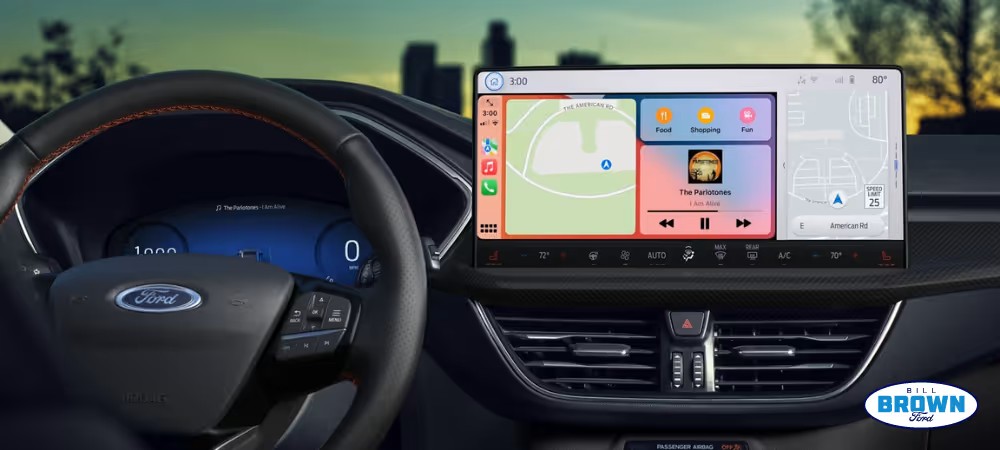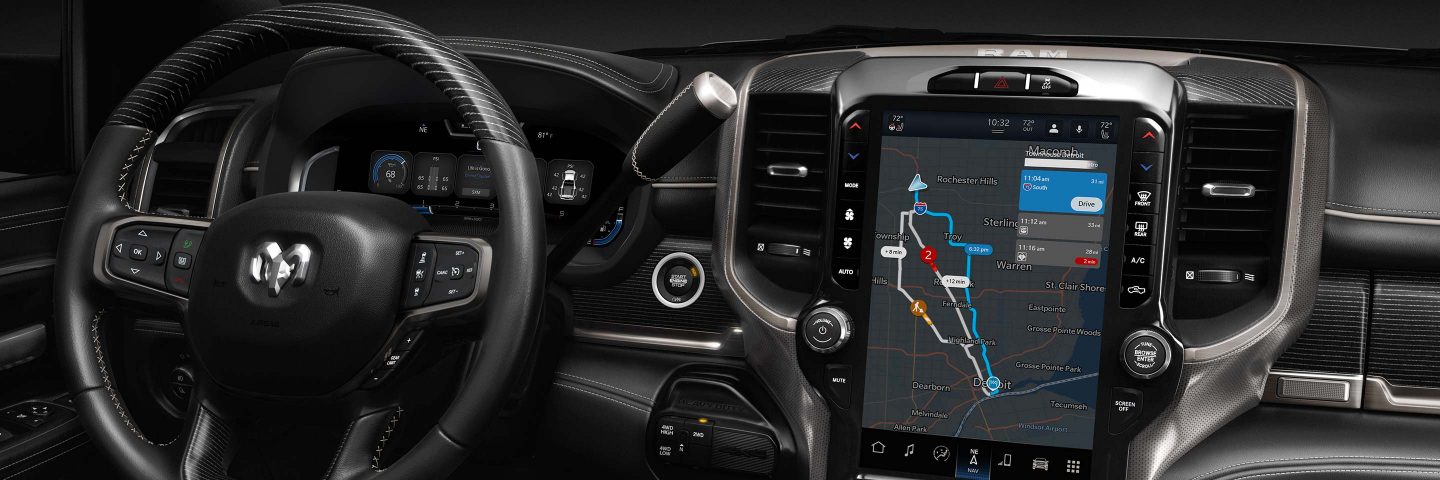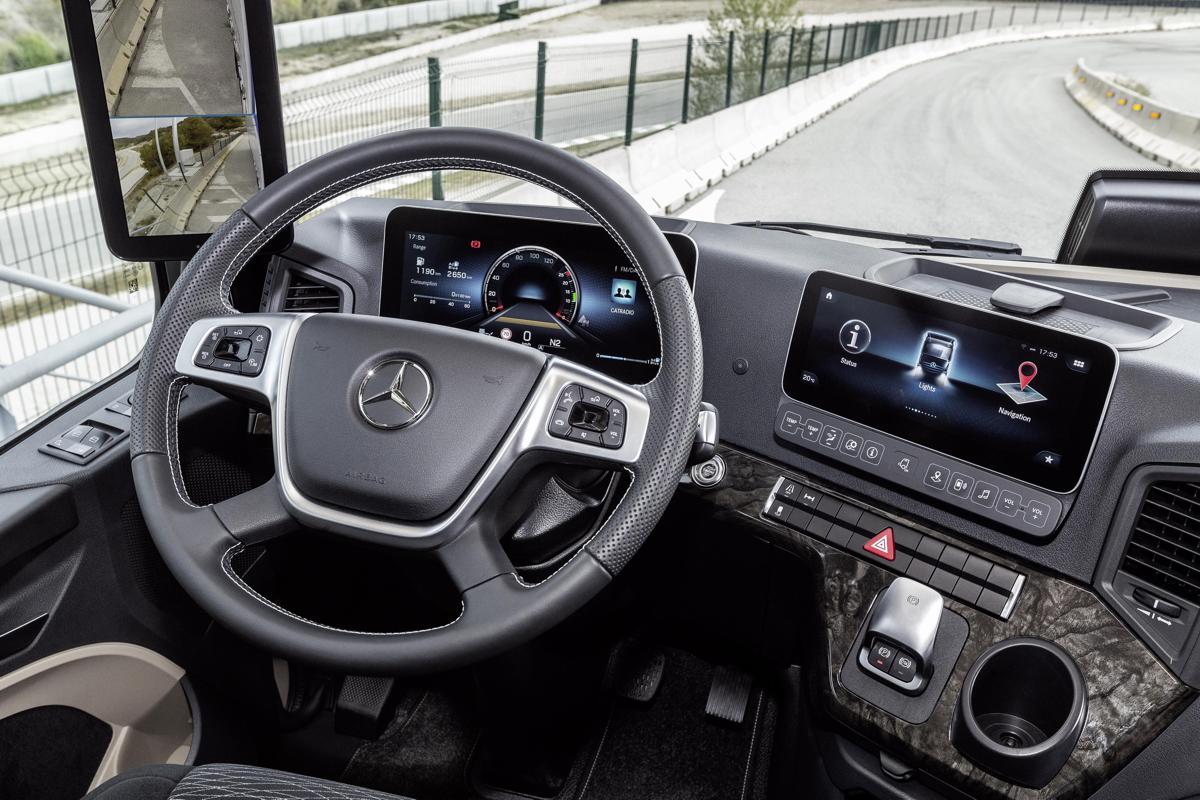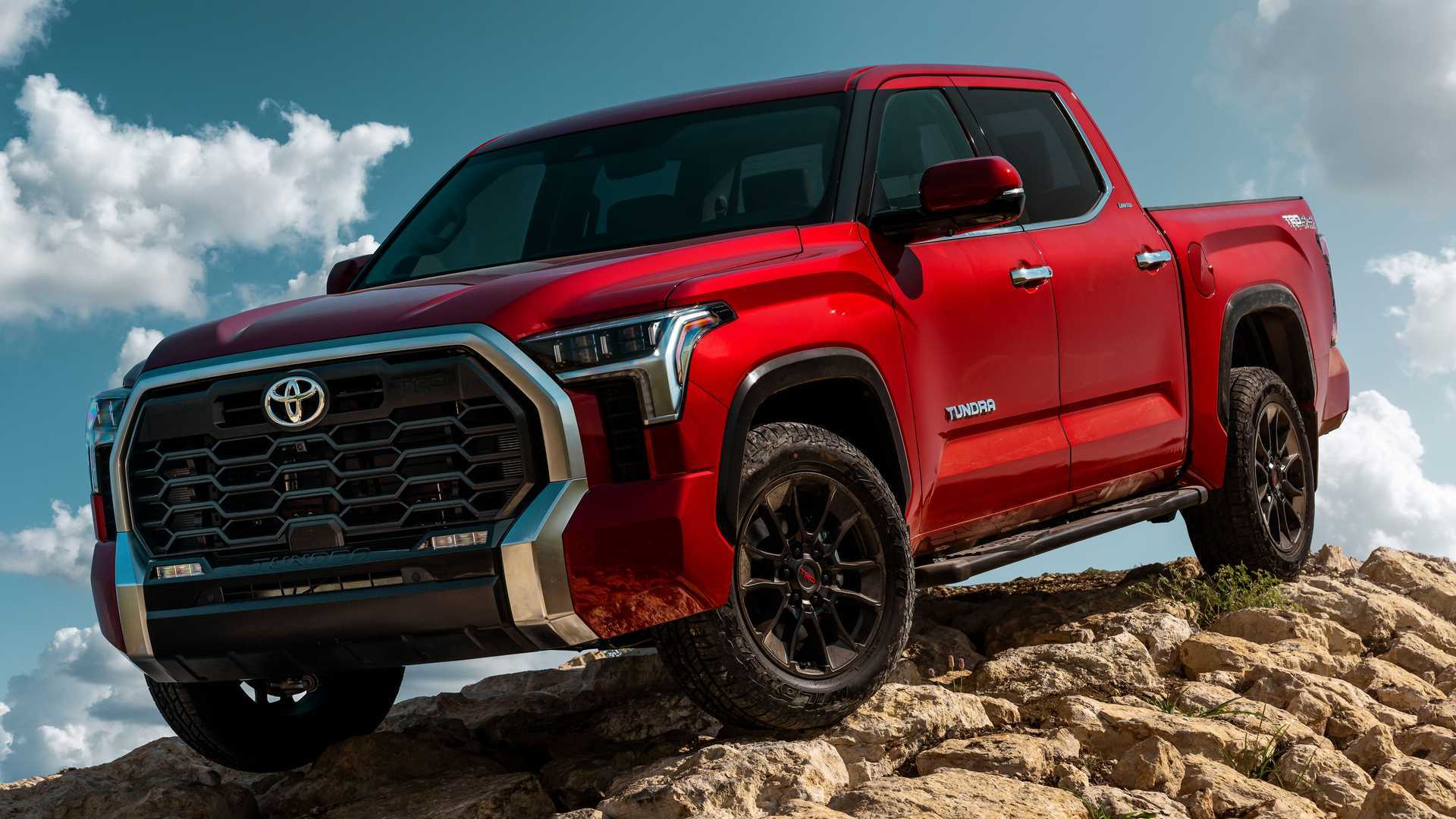In the rapidly evolving world of commercial trucking, navigation technology has become the backbone of efficient fleet operations and driver safety.
The distinction between trucks equipped with cutting-edge OEM navigation systems and those struggling with outdated mapping data has never been more critical.
As we navigate through 2025, the commercial trucking industry faces unprecedented challenges in route optimization, regulatory compliance, and operational efficiency, making reliable navigation systems essential for success.
Modern truck navigation systems go far beyond basic turn-by-turn directions. They incorporate sophisticated algorithms that account for vehicle dimensions, weight restrictions, bridge clearances, hazardous material routing, and hours-of-service regulations.
The best OEM navigation systems integrate seamlessly with vehicle telematics, providing real-time traffic updates, weather conditions, and fuel-efficient routing that can save thousands of dollars annually in operational costs.
However, the landscape is divided between manufacturers who prioritize navigation excellence and those whose systems lag behind industry standards.
Map updates are encouraged to get access to the latest roads and points of interest, which can change up to 15% every year. This statistic underscores the critical importance of maintaining current mapping data, as outdated information can lead to costly delays, regulatory violations, and safety hazards.
The following comprehensive analysis examines ten prominent truck manufacturers, categorizing them into two distinct groups: five that excel in OEM navigation capabilities and five that require immediate attention to their mapping systems.
This evaluation considers factors including map accuracy, update frequency, user interface design, integration capabilities, and overall reliability in real-world trucking scenarios.
5 Trucks with Superior OEM Navigation Maps
These exceptionally equipped vehicles feature comprehensive mapping systems and precision-calibrated GPS receivers that deliver accurate turn-by-turn directions through years of reliable navigation assistance across diverse terrain and road conditions.
Their thoughtful engineering includes robust satellite connectivity, detailed topographical databases, and advanced route-calculation algorithms that resist the positioning errors typically created by urban canyon effects or challenging weather interference patterns.
From remote construction sites that challenge standard GPS systems to constantly changing highway configurations, these remarkable navigation units continue providing precise guidance without developing signal drift or outdated routing information.
Owners report confident cross-country travel with these dependable mapping solutions, a productivity-enhancing quality feature that proves its worth through reduced travel time and eliminated wrong-turn frustrations throughout ownership.
1. Ford Super Duty Series with SYNC 4A Navigation
Ford’s Super Duty lineup has established itself as a benchmark in commercial vehicle navigation technology, particularly with the introduction of SYNC 4A across their heavy-duty truck range.
The system represents a quantum leap in automotive navigation, combining cloud-based processing with local mapping data to deliver unprecedented accuracy and reliability for commercial applications.
The SYNC 4A navigation system features a massive 12-inch touchscreen interface that displays detailed truck-specific routing information with crystal-clear graphics.
The system’s processor operates at lightning speed, calculating complex routes that account for vehicle specifications, load characteristics, and regulatory restrictions in real-time.
Ford has invested heavily in partnerships with HERE Technologies and other premium mapping providers to ensure their navigation data remains current and comprehensive.
What sets Ford’s navigation apart is its deep integration with the vehicle’s onboard systems. The navigation communicates directly with the engine control unit, transmission, and chassis systems to optimize routes based on current vehicle performance, fuel levels, and maintenance schedules.
This holistic approach means drivers receive routing recommendations that consider not just distance and time, but also fuel efficiency, engine load, and component wear patterns.
Ford provides regular updates through their SYNC and Navigation Update page, requiring Vehicle Identification Number (VIN) entry, ensuring each vehicle receives customized updates appropriate for its specific configuration and geographic operating area.

The update process is streamlined through USB downloads or over-the-air updates, minimizing downtime and ensuring drivers always have access to the latest mapping information.
Ford’s commitment to commercial navigation excellence extends beyond basic mapping. The system includes comprehensive databases of truck stops, service facilities, weigh stations, and inspection points.
Real-time traffic integration provides dynamic routing that can save hours on long-haul routes, while weather integration helps drivers avoid hazardous conditions. The voice recognition system is specifically tuned for truck cab environments, maintaining accuracy even with diesel engine noise and road vibration.
The system’s reliability has been proven through extensive testing in harsh commercial environments. Ford subjects their navigation systems to temperature extremes, vibration testing, and electromagnetic interference simulation to ensure consistent performance across all operating conditions.
This rigorous testing regimen has resulted in navigation systems that maintain accuracy and functionality even in the most demanding trucking applications.
Advanced features include predictive routing that learns from driver behavior and preferences, gradually optimizing suggested routes based on historical data.
The system can store multiple driver profiles, each with customized preferences for routing priorities, preferred truck stops, and avoiding specific road types or geographic areas.
Fleet managers can also push route preferences and restrictions to multiple vehicles simultaneously, ensuring compliance with company policies and customer requirements.
2. Ram Heavy Duty with Uconnect 5 Navigation
Ram’s Heavy Duty truck lineup has undergone a navigation revolution with the introduction of Uconnect 5, a system that sets new standards for commercial vehicle navigation technology.
Built on a powerful Android-based platform, Uconnect 5 combines the flexibility of smartphone-like operation with the ruggedness required for heavy-duty commercial applications.
The system’s 12-inch display provides exceptional visibility and touch responsiveness, even when operators are wearing work gloves. The interface design prioritizes essential trucking information, with large, clearly visible icons and text that remain legible in bright sunlight or complete darkness.
Ram has invested significantly in user experience research, conducting extensive testing with professional drivers to optimize the system’s operation for real-world trucking scenarios. Uconnect 5’s mapping capabilities leverage multiple data sources to provide comprehensive coverage of North American trucking routes.
The system maintains detailed databases of bridge clearances, weight restrictions, hazardous material routing, and seasonal road closures. Ram provides map updates for the Uconnect GPS navigation system with comprehensive product information and installation instructions, ensuring drivers have access to the most current routing information available.
One of Uconnect 5’s most impressive features is its advanced traffic integration. The system receives real-time traffic data from multiple sources, including government transportation agencies, commercial traffic providers, and crowdsourced information from other connected vehicles.

This multi-source approach provides exceptionally accurate traffic predictions, often alerting drivers to potential delays before they become visible to traffic monitoring systems.
The navigation system’s integration with Ram’s powertrain systems enables sophisticated fuel economy optimization. Routes are calculated considering current load weight, terrain elevation profiles, and engine performance characteristics.
The system can recommend optimal cruising speeds for different route segments, suggest gear selection strategies for manual transmissions, and coordinate with the engine’s exhaust aftertreatment system to minimize regeneration events during critical delivery windows.
Ram’s commitment to navigation accuracy extends to their update process, which has been streamlined for commercial fleet operations. Fleet managers can schedule updates during maintenance windows, and the system supports batch updating for multiple vehicles.
The update process includes verification protocols that ensure mapping data integrity and compatibility with vehicle-specific configurations. The voice command system in Uconnect 5 has been specifically optimized for trucking environments.
Advanced noise cancellation algorithms filter out diesel engine noise, air brake sounds, and road noise to maintain accurate voice recognition. The system supports natural language commands, allowing drivers to request routing changes, search for facilities, or access vehicle information without taking their hands off the steering wheel.
Uconnect 5 also excels in connectivity options, supporting multiple smartphone platforms simultaneously and providing dedicated connectivity for electronic logging devices, fleet management systems, and telematics equipment.
This comprehensive connectivity ensures that navigation functions integrate seamlessly with other essential trucking technologies, creating a unified operational environment that enhances both safety and efficiency.
3. Chevrolet Silverado HD with Infotainment 3 Plus Navigation
Chevrolet’s Silverado HD lineup represents a significant advancement in heavy-duty truck navigation technology through the implementation of Infotainment 3 Plus, a comprehensive system designed specifically for commercial trucking applications.
General Motors has leveraged decades of automotive technology development to create a navigation platform that addresses the unique challenges faced by commercial truck operators.
The Infotainment 3 Plus system features a high-resolution 13.4-inch diagonal touchscreen that serves as the central hub for all navigation and vehicle management functions.
The display utilizes advanced LCD technology with exceptional brightness and contrast ratios, ensuring perfect visibility in all lighting conditions. The interface design reflects extensive collaboration with professional drivers, resulting in an intuitive layout that minimizes distraction while maximizing functionality.
Chevrolet’s mapping database incorporates data from multiple premium sources, including HERE Technologies, TomTom, and specialized commercial routing providers.
This multi-source approach ensures comprehensive coverage of truck-specific routing information, including detailed data on bridge clearances, weight restrictions, turning radii, and seasonal road conditions.
The system maintains separate databases for different truck configurations, ensuring that routing recommendations are tailored to specific vehicle dimensions and weight categories.
The navigation system’s integration with OnStar services provides additional layers of functionality and reliability. OnStar’s cellular connectivity enables real-time traffic updates, weather information, and emergency services coordination.
The system can automatically contact emergency services in the event of an accident, providing precise location information and vehicle identification details to first responders.
This integration has proven invaluable in remote areas where cellular coverage might be limited but OnStar’s satellite backup systems remain operational.

Advanced route optimization algorithms consider multiple factors beyond basic distance and time calculations. The system analyzes fuel prices along potential routes, suggesting stops at cost-effective fueling locations.
Real-time fuel economy monitoring integrates with route planning to provide accurate arrival time estimates and fuel consumption predictions. The system can even coordinate with the vehicle’s diesel exhaust fluid monitoring system to suggest DEF refill locations along planned routes.
Chevrolet has implemented sophisticated update mechanisms that ensure mapping data remains current without requiring extensive downtime. The system supports over-the-air updates for most mapping data, with automatic scheduling that occurs during vehicle rest periods.
Critical updates can be prioritized and installed immediately, while routine updates are queued for optimal timing. The update process includes comprehensive verification protocols that prevent corrupted data from affecting navigation performance.
The voice recognition system in Infotainment 3 Plus utilizes advanced machine learning algorithms that adapt to individual driver speech patterns and preferences.
The system can process complex multi-part commands, such as “Navigate to the nearest truck stop with diesel fuel and parking, avoiding toll roads.” This natural language processing capability significantly reduces the time and attention required for navigation system interaction.
Integration with fleet management systems is another area where Chevrolet excels. The navigation system can receive route assignments from dispatch systems, automatically calculating optimal paths while considering driver hours-of-service restrictions.
Compliance monitoring features track driving time, break requirements, and routing adherence, providing real-time feedback to both drivers and fleet managers. This integration helps ensure regulatory compliance while optimizing operational efficiency.
4. GMC Sierra HD with Advanced Navigation Technology
GMC’s Sierra HD lineup showcases the company’s commitment to premium navigation technology through its Advanced Navigation Technology package, a sophisticated system that elevates commercial trucking operations to new levels of efficiency and safety.
As General Motors’ premium truck brand, GMC has invested heavily in developing navigation solutions that meet the demanding requirements of professional drivers and fleet operators.
The Advanced Navigation Technology system centers around a massive 15-inch diagonal touchscreen display, the largest available in the heavy-duty truck segment.
This expansive display provides exceptional visibility for complex navigation information, allowing drivers to view detailed route maps, traffic conditions, and vehicle status information simultaneously.
The display utilizes OLED technology for superior color reproduction and contrast, ensuring perfect visibility even in challenging lighting conditions.
GMC’s mapping database represents a significant investment in commercial routing accuracy and comprehensiveness. The system incorporates specialized databases for hazardous materials routing, oversized load permits, and seasonal weight restrictions.
Real-time integration with state and provincial transportation agencies provides immediate updates on road closures, construction zones, and emergency routing restrictions.
This level of integration ensures that GMC Sierra HD operators have access to the most current and accurate routing information available. The navigation system’s predictive capabilities set it apart from conventional truck navigation solutions.
Advanced algorithms analyze historical traffic patterns, weather forecasts, and seasonal shipping trends to provide highly accurate arrival time predictions.
The system can recommend optimal departure times for specific routes, considering factors such as anticipated traffic congestion, weather conditions, and driver hours-of-service requirements. This predictive approach helps optimize delivery schedules and reduce overall transportation costs.

GMC’s commitment to navigation excellence extends to their comprehensive driver assistance features. The navigation system integrates with the truck’s advanced driver assistance systems, providing enhanced situational awareness through features like predictive curve speed warnings, steep grade alerts, and upcoming traffic signal information.
The system can automatically adjust vehicle settings based on upcoming route conditions, such as engaging exhaust brake systems before steep descents or optimizing transmission shift patterns for upcoming terrain.
The update process for GMC’s Advanced Navigation Technology represents a significant advancement in fleet management efficiency. The system supports multiple update methods, including over-the-air updates, USB installation, and dealer-based updates.
Fleet managers can schedule updates across multiple vehicles simultaneously, with automated verification and rollback capabilities that ensure system stability.
The update process includes comprehensive logging and reporting features that provide detailed information about update success rates and any potential issues.
Voice control capabilities in the GMC system utilize cutting-edge artificial intelligence algorithms that provide natural language processing and contextual understanding.
The system can process complex routing requests, understand driver preferences, and maintain conversation context across multiple commands. Advanced noise cancellation technology ensures accurate voice recognition even in noisy truck cab environments, while multi-language support accommodates diverse driver populations.
Integration with GMC’s proprietary fleet management systems provides unprecedented visibility into vehicle operations and navigation performance. Fleet managers can monitor route adherence, identify optimization opportunities, and provide real-time routing updates to drivers.
The system supports geofencing capabilities that can automatically notify managers when vehicles enter or exit specific geographic areas, enhancing security and operational oversight.
The Advanced Navigation Technology system also excels in its integration with vehicle maintenance systems. The navigation can factor upcoming maintenance requirements into route planning, suggesting service facility stops that align with planned routes.
Predictive maintenance algorithms analyze navigation usage patterns to anticipate component wear and recommend proactive maintenance schedules. This integration helps maximize vehicle uptime while minimizing maintenance costs.
Also Read: 5 Sedans With Best Throttle Response And 5 That Are Sluggish
5. Mercedes-Benz Actros with Mercedes-Benz Advanced Navigation
Mercedes-Benz has established itself as the pinnacle of commercial vehicle navigation technology with the Actros lineup’s Advanced Navigation system, a sophisticated platform that exemplifies German engineering excellence applied to trucking operations.
The system represents Mercedes-Benz’s commitment to combining luxury automotive technology with the demanding requirements of commercial transportation.
The Advanced Navigation system features a stunning 12.3-inch high-resolution display that utilizes the same advanced graphics processing technology found in Mercedes-Benz luxury passenger vehicles.
The interface design reflects the company’s commitment to operational efficiency and driver comfort, with intuitive controls and customizable display options that adapt to individual driver preferences and operational requirements.
The system’s processing power enables real-time rendering of detailed 3D maps with photorealistic terrain representation and landmark identification.
Mercedes-Benz’s mapping database represents one of the most comprehensive commercial routing resources available in the trucking industry. The system incorporates detailed European road network data through partnerships with premium mapping providers, while North American coverage utilizes specialized databases optimized for heavy-duty commercial operations.
The mapping data includes precise information about bridge clearances, weight restrictions, turning radii, and hazardous materials routing, all verified through Mercedes-Benz’s extensive testing and validation processes.
The navigation system’s integration with Mercedes-Benz’s advanced powertrains provides unparalleled fuel efficiency optimization. The system communicates directly with the engine management system, transmission controls, and exhaust aftertreatment systems to optimize performance for specific route conditions.
Predictive powertrain control analyzes upcoming terrain and traffic conditions to optimize gear selection, engine braking, and regenerative systems. This integration can result in fuel savings of up to 8% compared to conventional navigation systems.

Advanced traffic integration capabilities set the Mercedes-Benz system apart from competitors. The navigation receives real-time traffic data from multiple sources, including government transportation agencies, commercial traffic providers, and Mercedes-Benz’s proprietary fleet data network.
This comprehensive traffic information enables dynamic routing that can save significant time on long-haul routes. The system’s predictive algorithms can anticipate traffic conditions several hours in advance, allowing for proactive route optimization.
Mercedes-Benz’s approach to navigation updates reflects its commitment to system reliability and data accuracy. Updates are thoroughly tested in Mercedes-Benz’s extensive validation laboratories before release to ensure compatibility and stability.
The update process utilizes secure cryptographic protocols to prevent tampering and ensure data integrity. Fleet managers can schedule updates during maintenance windows, with automated verification systems that confirm successful installation and system functionality.
The voice command system in Mercedes-Benz Advanced Navigation utilizes state-of-the-art natural language processing algorithms developed specifically for commercial vehicle environments.
The system can understand complex multi-part commands and maintain conversation context across extended interactions. Advanced acoustic modeling compensates for diesel engine noise, road noise, and other environmental factors to maintain exceptional voice recognition accuracy.
Integration with Mercedes-Benz’s comprehensive telematics platform provides unprecedented fleet management capabilities. The navigation system can receive route assignments from fleet management systems, automatically optimizing paths while considering driver qualifications, vehicle capabilities, and regulatory requirements.
Real-time monitoring capabilities allow fleet managers to track route adherence, identify optimization opportunities, and provide immediate support to drivers when needed.
The system’s reliability has been validated through extensive testing in harsh commercial environments worldwide. Mercedes-Benz subjects its navigation systems to extreme temperature testing, vibration simulation, and electromagnetic interference validation to ensure consistent performance across all operating conditions.
This rigorous testing regimen has resulted in navigation systems that maintain exceptional accuracy and functionality even in the most demanding trucking applications.
5 Trucks Needing Navigation Map Updates
These mapping-challenged vehicles require frequent database refreshes due to outdated cartographic information and slow-updating satellite connectivity that fails to reflect current road networks, construction zones, or newly developed commercial areas.
Their aging systems include limited processing power, insufficient memory storage, and basic route-calculation capabilities that struggle with real-time traffic patterns and dynamic routing adjustments.
From missing highway interchanges that opened years ago to directing drivers through closed construction areas, these navigation systems demand regular attention to maintain basic functionality.
Owners discover that while these trucks offer solid mechanical reliability, their navigation technology requires costly update subscriptions and frequent manual corrections to provide even marginally acceptable routing guidance for modern driving needs.
1. Toyota Tundra Commercial Series
Toyota’s Tundra Commercial Series, while renowned for mechanical reliability and durability, faces significant challenges in navigation technology that have become increasingly apparent as the trucking industry evolves toward more sophisticated route optimization and fleet management requirements.
The current navigation system, based on older hardware and software architectures, struggles to meet the demands of modern commercial operations.
The existing navigation system in the Tundra Commercial Series utilizes a smaller 8-inch display that lacks the resolution and processing power necessary for complex commercial routing tasks.
The interface design, while functional for basic navigation, fails to provide the detailed information required for commercial truck operations. Critical data such as bridge clearances, weight restrictions, and hazardous materials routing are either missing or presented in formats that are difficult to interpret quickly while driving.
Navigation system issues include unresponsive systems, outdated map data, and malfunctioning components, problems that have become increasingly common as the system ages.
The mapping database in many Tundra Commercial Series vehicles dates back several years, missing critical infrastructure updates, new road construction, and changed traffic patterns. This outdated information can lead to routing errors that result in delays, increased fuel consumption, and potential safety hazards.
Toyota’s update process for the Tundra navigation system has proven cumbersome and time-consuming for commercial fleet operators. Updates require physical media installation or dealership visits, creating operational disruptions that fleet managers struggle to accommodate.

The update process itself is slow and requires significant vehicle downtime, making it impractical for high-utilization commercial vehicles. Many fleet operators have abandoned the OEM navigation system in favor of aftermarket solutions or smartphone applications.
The navigation system’s integration with other vehicle systems is minimal, limiting its effectiveness for commercial operations. The system cannot communicate with engine management systems to optimize fuel consumption, nor does it integrate with fleet management platforms for route assignment and monitoring.
This lack of integration forces drivers to rely on multiple separate systems, increasing complexity and reducing operational efficiency. Processing speed represents another significant limitation of the current Toyota navigation system.
Route calculations, especially for complex commercial routes with multiple restrictions and preferences, can take several minutes to complete. Real-time traffic updates are delayed or inconsistent, often providing outdated information that fails to reflect current road conditions.
The system’s limited processing power also prevents it from handling multiple simultaneous tasks, such as navigation, traffic monitoring, and fleet communication.
Voice recognition capabilities in the Toyota system are particularly problematic for commercial applications. The system struggles with background noise common in commercial vehicle environments, frequently misinterpreting commands or failing to respond entirely.
The limited vocabulary and rigid command structure make it difficult for drivers to interact with the system efficiently, often requiring multiple attempts to execute simple navigation tasks.
The mapping database coverage is another area where the Toyota system falls short of commercial requirements. Rural and industrial area coverage is inconsistent, with many truck-specific facilities and routes missing from the database.
Construction zone updates are infrequent, leaving drivers without current information about road closures, detours, and temporary restrictions that can significantly impact delivery schedules.
Fleet management integration capabilities are virtually non-existent in the current Toyota navigation system. The system cannot receive route assignments from dispatch systems, nor can it provide real-time location and status updates to fleet managers.
This limitation forces fleet operators to rely on separate telematics systems, increasing costs and system complexity while reducing operational efficiency.
2. Nissan Titan XD Commercial Package
Nissan’s Titan XD Commercial Package represents a significant missed opportunity in the commercial vehicle navigation market, with a system that fails to meet the basic requirements of modern trucking operations.
Despite Nissan’s reputation for innovative technology in passenger vehicles, the Titan XD’s navigation system reflects outdated design philosophies and limited investment in commercial-specific features.
The navigation system in the Titan XD utilizes a 9-inch touchscreen display that, while adequate for passenger vehicle applications, lacks the size and resolution necessary for commercial navigation tasks.
The display struggles with visibility in bright sunlight conditions common in commercial vehicle operations, and the touch interface becomes unreliable when operated with work gloves or in high-vibration environments typical of commercial use.
Mapping data accuracy represents a critical weakness in the Titan XD navigation system. Many navigation systems suffer from terribly outdated map versions, with some showing data that is several years old.
The Titan XD’s mapping database lacks comprehensive truck-specific information, including accurate bridge clearance data, weight restriction details, and hazardous materials routing capabilities.
This deficiency forces commercial operators to rely on additional resources for critical routing decisions, undermining the utility of the integrated navigation system.
The update process for Titan XD navigation maps has proven problematic for commercial fleet operators. Nissan’s update methodology requires manual intervention and significant vehicle downtime, making it impractical for high-utilization commercial vehicles.
Update costs are substantial, and the frequency of updates is insufficient to maintain current mapping data in rapidly changing transportation environments. Many fleet operators report abandoning update attempts due to complexity and cost considerations.

Processing performance in the Titan XD navigation system is inadequate for commercial routing requirements. Complex route calculations involving multiple stops, vehicle restrictions, and preference settings can overwhelm the system’s limited processing capabilities.
The system frequently experiences delays, freezes, or crashes when attempting to process demanding navigation tasks, forcing drivers to restart the system and potentially lose route information.
Integration capabilities with fleet management systems are essentially non-existent in the Titan XD navigation platform. The system cannot communicate with external fleet management software, electronic logging devices, or telematics platforms commonly used in commercial operations.
This isolation prevents efficient route assignment, real-time monitoring, and performance optimization that are standard requirements in modern fleet operations.
Traffic integration in the Titan XD system relies on outdated data sources and delivery methods that provide inconsistent and often inaccurate traffic information.
Real-time traffic updates are infrequent, and the system’s algorithms fail to provide effective alternative routing when traffic conditions change. The traffic data integration also lacks commercial vehicle-specific information, such as truck-restricted routes and commercial vehicle traffic patterns.
Voice recognition technology in the Titan XD navigation system represents a significant frustration for commercial drivers. The system’s limited vocabulary and rigid command structure make it difficult to use effectively in real-world driving conditions.
Background noise filtering is inadequate for commercial vehicle environments, resulting in frequent recognition errors and command failures. The system’s inability to understand natural language commands forces drivers to memorize specific command phrases, reducing operational efficiency.
The navigation system’s reliability has been questioned by commercial users, with frequent reports of system failures, incorrect routing, and data corruption.
The system’s hardware appears inadequately protected against the vibration, temperature extremes, and electromagnetic interference common in commercial vehicle environments. These reliability issues have led many commercial operators to view the navigation system as unreliable for critical transportation tasks.
3. Honda Ridgeline Commercial Trim
Honda’s Ridgeline Commercial Trim, while offering unique features in the mid-size truck segment, presents significant challenges in navigation technology that limit its effectiveness for commercial applications.
The navigation system represents a carried-over design from passenger vehicle applications, failing to address the specific requirements of commercial truck operations.
The current navigation system utilizes an 8-inch display that lacks the screen real estate necessary for displaying complex commercial routing information.
The interface design prioritizes consumer-friendly features over commercial functionality, resulting in a system that requires multiple menu levels to access truck-specific information.
The display’s resolution and processing capabilities are insufficient for rendering detailed mapping information with the clarity required for commercial navigation tasks.
Honda navigation systems often show terribly outdated software versions, with some systems showing map data that is years behind current. The Ridgeline’s mapping database lacks comprehensive commercial vehicle routing information, including accurate truck restriction data, commercial facility locations, and specialized routing requirements for different load types.
This deficiency forces commercial operators to supplement the OEM navigation with additional resources, reducing operational efficiency. Honda’s approach to navigation updates has proven inadequate for commercial fleet requirements.
The update process is complex, requiring multiple steps and significant technical knowledge to complete successfully. Update costs are substantial relative to the value provided, and the frequency of updates is insufficient to maintain current mapping data.
Many commercial operators report difficulty obtaining and installing updates, leading to systems that become increasingly outdated over time.

The navigation system’s integration with vehicle systems is minimal, preventing effective optimization of commercial operations. The system cannot communicate with engine management systems to provide fuel-efficient routing recommendations, nor can it integrate with trailer monitoring systems for comprehensive vehicle management.
This lack of integration limits the system’s ability to provide value-added services that are increasingly expected in commercial applications. Processing performance represents a significant limitation of the Honda navigation system.
Route calculations involving multiple stops or complex routing preferences can overwhelm the system’s processing capabilities, resulting in extended calculation times or system failures.
Real-time traffic processing is particularly problematic, with the system often failing to incorporate current traffic conditions into routing decisions effectively.
The navigation system’s traffic integration relies on consumer-grade data sources that lack the commercial vehicle-specific information necessary for effective truck routing.
The system fails to account for truck-restricted routes, commercial vehicle traffic patterns, and specialized routing requirements that affect commercial operations.
Traffic update frequency is inadequate for dynamic commercial routing requirements, often providing outdated information that fails to reflect current conditions.
Voice control capabilities in the Honda system are particularly problematic for commercial applications. The system’s voice recognition algorithms are optimized for quiet passenger vehicle environments and perform poorly in the noisier conditions typical of commercial operations.
Command vocabulary is limited, and the system frequently fails to understand driver inputs, forcing reliance on manual interface interaction that can be dangerous while driving.
Fleet management integration is virtually non-existent in the Honda navigation system. The system cannot receive route assignments from fleet management platforms, nor can it provide real-time vehicle location and status information to fleet operators.
This limitation forces commercial operators to rely on separate telematics systems, increasing complexity and operational costs while reducing system effectiveness.
The system’s reliability has been questioned by commercial users, with reports of frequent system crashes, data corruption, and hardware failures.
The navigation hardware appears inadequately designed for the demanding conditions of commercial vehicle operations, including temperature extremes, vibration, and electromagnetic interference. These reliability issues have led many commercial operators to seek alternative navigation solutions.
4. Jeep Gladiator Commercial Package
The Jeep Gladiator Commercial Package, despite its impressive off-road capabilities and rugged construction, suffers from navigation technology limitations that significantly impact its effectiveness in commercial applications.
The navigation system represents a consumer-oriented design that fails to address the specialized requirements of commercial truck operations, particularly in challenging terrain and remote work environments where Gladiator vehicles are commonly deployed.
The Uconnect navigation system in the Gladiator utilizes a 8.4-inch touchscreen display that proves inadequate for commercial navigation requirements.
The display lacks the resolution and brightness necessary for effective use in bright outdoor conditions common in construction, utilities, and other commercial applications.
The interface design prioritizes consumer features over commercial functionality, requiring excessive menu navigation to access essential trucking information.
Mapping database limitations represent a critical weakness in the Gladiator’s navigation system. The system lacks comprehensive coverage of off-road routes, industrial access roads, and remote work sites that are frequently destinations for commercial Gladiator operations.
Map updates are essential as mapping data changes significantly, with some areas requiring frequent updates, but the Gladiator’s update process is cumbersome and inadequate for commercial fleet requirements.
The navigation system’s off-road capabilities, while present, are insufficient for serious commercial off-road operations. The system lacks detailed topographic information, trail difficulty ratings, and obstacle identification that are essential for safe navigation in challenging terrain. GPS accuracy in dense forest or mountainous terrain is often inadequate, and the system lacks backup navigation methods when satellite reception is compromised.

Processing performance in demanding commercial environments has proven problematic for the Gladiator’s navigation system. Complex route calculations in remote areas with limited road infrastructure can overwhelm the system’s processing capabilities.
The system frequently experiences delays or failures when attempting to calculate routes in areas with sparse mapping data or complex terrain considerations.
Integration with commercial equipment and fleet management systems is minimal in the Gladiator navigation platform. The system cannot communicate with work equipment controls, material handling systems, or specialized commercial accessories commonly installed on commercial Gladiator vehicles.
This lack of integration prevents comprehensive vehicle management and reduces operational efficiency in commercial applications. Traffic integration capabilities are particularly limited for the Gladiator’s typical commercial applications.
The system relies on consumer-grade traffic data sources that provide minimal coverage in rural and remote areas where commercial Gladiator vehicles frequently operate.
Real-time traffic updates are inconsistent or unavailable in these areas, limiting the system’s ability to provide effective routing alternatives when road conditions change.
The navigation system’s durability and reliability in harsh commercial environments have been questionable. While the Gladiator vehicle itself is designed for rugged use, the navigation system’s electronic components appear inadequately protected against dust, moisture, vibration, and temperature extremes common in commercial off-road operations.
System failures and component degradation have been reported in demanding commercial applications. Voice recognition performance in the Gladiator navigation system is particularly problematic for commercial operations.
The system struggles with background noise from work equipment, diesel engines, and outdoor environments typical of commercial use. Command recognition accuracy is poor, and the limited vocabulary prevents effective interaction with the system during work operations.
Update procedures for the Gladiator navigation system are ill-suited to commercial fleet requirements. Updates require dealership visits or complex manual procedures that are impractical for high-utilization commercial vehicles.
Update costs are substantial, and the frequency of updates is insufficient to maintain current mapping data for rapidly changing commercial work environments.
5. Mitsubishi L200 Commercial Series
Mitsubishi’s L200 Commercial Series represents perhaps the most significant navigation technology shortcoming in the commercial truck segment, with a system that fails to meet even basic requirements for commercial vehicle operations.
The navigation platform reflects outdated technology and minimal investment in commercial-specific features, resulting in a system that many commercial operators view as inadequate for professional use.
The navigation system in the L200 Commercial Series utilizes a small 7-inch display that lacks the screen real estate necessary for effective commercial navigation.
The display resolution is insufficient for detailed mapping information, and the interface design appears outdated compared to modern navigation systems. Touch response is often sluggish or inaccurate, making system interaction difficult while driving or wearing work gloves.
Mapping database coverage and accuracy represent critical weaknesses in the L200 navigation system. The system lacks comprehensive truck-specific routing information, including bridge clearances, weight restrictions, and commercial vehicle routing preferences.
Many commercial facilities, truck stops, and service locations are missing from the database, forcing drivers to rely on external resources for essential navigation information.
The update process for L200 navigation maps has proven to be one of the most problematic in the industry. Updates are infrequent, expensive, and require complex manual installation procedures that are impractical for commercial fleet operations.
Many fleet operators report difficulty obtaining updates, and those who attempt installation often encounter compatibility issues or system failures that render the navigation system inoperable.

Processing performance in the L200 navigation system is inadequate for commercial routing requirements. Simple route calculations can take excessive time to complete, and complex routing involving multiple stops or restrictions often results in system failures or incorrect routing recommendations.
Real-time traffic processing is particularly problematic, with the system frequently failing to incorporate current traffic conditions into routing decisions.
Integration capabilities with other vehicle systems and fleet management platforms are virtually non-existent in the L200 navigation system. The system operates in isolation, unable to communicate with engine management systems, telematics platforms, or fleet management software.
This limitation prevents effective optimization of commercial operations and forces operators to rely on multiple separate systems. The navigation system’s reliability has been consistently problematic, with frequent reports of system crashes, data corruption, and hardware failures.
The system appears inadequately designed for the demanding conditions of commercial vehicle operations, including vibration, temperature fluctuations, and electromagnetic interference. These reliability issues have led many commercial operators to abandon the OEM navigation system entirely.
Voice recognition capabilities are essentially non-functional in the L200 navigation system. The system’s limited vocabulary and poor noise filtering make it ineffective in commercial vehicle environments.
Most commercial operators report that voice commands are unreliable and often counterproductive, leading to reliance on manual interface interaction that can be dangerous while driving.
Traffic integration in the L200 system relies on outdated data sources and delivery methods that provide inconsistent and often inaccurate traffic information.
The system lacks real-time traffic capabilities, and static traffic data is frequently outdated or incorrect. This limitation prevents effective dynamic routing and reduces the system’s utility for time-sensitive commercial operations.
The navigation system’s mapping database lacks coverage in many areas where commercial L200 vehicles operate, particularly in rural, industrial, and developing regions.
Road network information is often incomplete or inaccurate, and the system fails to provide reliable routing in areas with complex road systems or frequent construction activity. This limitation has led many commercial operators to view the navigation system as unreliable for critical transportation tasks.
Also Read: 5 Trucks With Best Sway-control Towing And 5 That Wander

